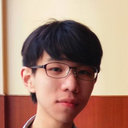About
24
Publications
1,343
Reads
How we measure 'reads'
A 'read' is counted each time someone views a publication summary (such as the title, abstract, and list of authors), clicks on a figure, or views or downloads the full-text. Learn more
1,068
Citations
Introduction
I'm a first year graduate student at the Information Systems and Applications at National Tsing Hua University, supervised by Prof. Min Sun (VSLab) and Prof. Hwann-Tzong Chen (VLLab). My research interests encompass wide application of Computer Vision and Deep Learning application. Recently focusing on the topic of scene modeling and 3D geometry.
Publications
Publications (24)
We propose ImGeoNet, a multi-view image-based 3D object detection framework that models a 3D space by an image-induced geometry-aware voxel representation. Unlike previous methods which aggregate 2D features into 3D voxels without considering geometry, ImGeoNet learns to induce geometry from multi-view images to alleviate the confusion arising from...
Reconstructing the shape and spatially varying surface appearances of a physical-world object as well as its surrounding illumination based on 2D images (e.g., photographs) of the object has been a long-standing problem in computer vision and graphics. In this paper, we introduce a robust object reconstruction pipeline combining neural based object...
Collecting and labeling the registered 3D point cloud is costly. As a result, 3D resources for training are typically limited in quantity compared to the 2D images counterpart. In this work, we deal with the data scarcity challenge of 3D tasks by transferring knowledge from strong 2D models via RGB-D images. Specifically, we utilize a strong and we...
This paper aims to address a new task of image morphing under a multiview setting, which takes two sets of multiview images as the input and generates intermediate renderings that not only exhibit smooth transitions between the two input sets but also ensure visual consistency across different views at any transition state. To achieve this goal, we...
This paper aims to address a new task of image morphing under a multiview setting, which takes two sets of multiview images as the input and generates intermediate renderings that not only exhibit smooth transitions between the two input sets but also ensure visual consistency across different views at any transition state. To achieve this goal, we...
In this technical report, we improve the DVGO framework (called DVGOv2), which is based on Pytorch and uses the simplest dense grid representation. First, we re-implement part of the Pytorch operations with cuda, achieving 2-3x speedup. The cuda extension is automatically compiled just in time. Second, we extend DVGO to support Forward-facing and U...
We present the first self-supervised method to train panoramic room layout estimation models without any labeled data. Unlike per-pixel dense depth that provides abundant correspondence constraints, layout representation is sparse and topological, hindering the use of self-supervised reprojection consistency on images. To address this issue, we pro...
Collecting and labeling the registered 3D point cloud is costly. As a result, 3D resources for training are typically limited in quantity compared to the 2D images counterpart. In this work, we deal with the data scarcity challenge of 3D tasks by transferring knowledge from strong 2D models via RGB-D images. Specifically, we utilize a strong and we...
We present a super-fast convergence approach to reconstructing the per-scene radiance field from a set of images that capture the scene with known poses. This task, which is often applied to novel view synthesis, is recently revolutionized by Neural Radiance Field (NeRF) for its state-of-the-art quality and flexibility. However, NeRF and its varian...
We present a novel pyramidal output representation to ensure parsimony with our "specialize and fuse" process for semantic segmentation. A pyramidal "output" representation consists of coarse-to-fine levels, where each level is "specialize" in a different class distribution (e.g., more stuff than things classes at coarser levels). Two types of pyra...
Indoor panorama typically consists of human-made structures parallel or perpendicular to gravity. We leverage this phenomenon to approximate the scene in a 360-degree image with (H)orizontal-planes and (V)ertical-planes. To this end, we propose an effective divide-and-conquer strategy that divides pixels based on their plane orientation estimation;...
We present Omnidirectional Neural Radiance Fields (OmniNeRF), the first method to the application of parallax-enabled novel panoramic view synthesis. Recent works for novel view synthesis focus on perspective images with limited field-of-view and require sufficient pictures captured in a specific condition. Conversely, OmniNeRF can generate panoram...
We present HoHoNet, a versatile and efficient framework for holistic understanding of an indoor 360-degree panorama using a Latent Horizontal Feature (LHFeat). The compact LHFeat flattens the features along the vertical direction and has shown success in modeling per-column modality for room layout reconstruction. HoHoNet advances in two important...
This paper proposes a new approach, Flat2Layout, for estimating general indoor room layout from a single-view RGB image whereas existing methods can only produce layout topologies captured from the box-shaped room. The proposed flat representation encodes the layout information into row vectors which are treated as the training target of the deep m...
We present a new approach to the problem of estimating 3D room layout from a single panoramic image. We represent room layout as three 1D vectors that encode, at each image column, the boundary positions of floor-wall and ceiling-wall, and the existence of wall-wall boundary. The proposed network architecture, HorizonNet, trained for predicting 1D...






![Surface reconstruction quality on DTU dataset [14]. The results are...](publication/370296122/figure/tbl1/AS:11431281153819451@1682565701370/Surface-reconstruction-quality-on-DTU-dataset-14-The-results-are-averaged-across-the_Q320.jpg)














![Accuracy of 3D object classification in ModelNet40 [38] dataset under...](publication/359278022/figure/tbl4/AS:1134457658585088@1647487191189/Accuracy-of-3D-object-classification-in-ModelNet40-38-dataset-under-limited-training_Q320.jpg)










![Figure 7: The detailed network architecture with ResNet50 [9] backbone.](profile/Cheng-Sun-34/publication/346143638/figure/fig1/AS:961246505496578@1606190434319/The-detailed-network-architecture-with-ResNet50-9-backbone_Q320.jpg)
![Figure 8: Comparison of the proposed EHC block and the HC block in [20].](profile/Cheng-Sun-34/publication/346143638/figure/fig2/AS:961246505472002@1606190434348/Comparison-of-the-proposed-EHC-block-and-the-HC-block-in-20_Q320.jpg)













